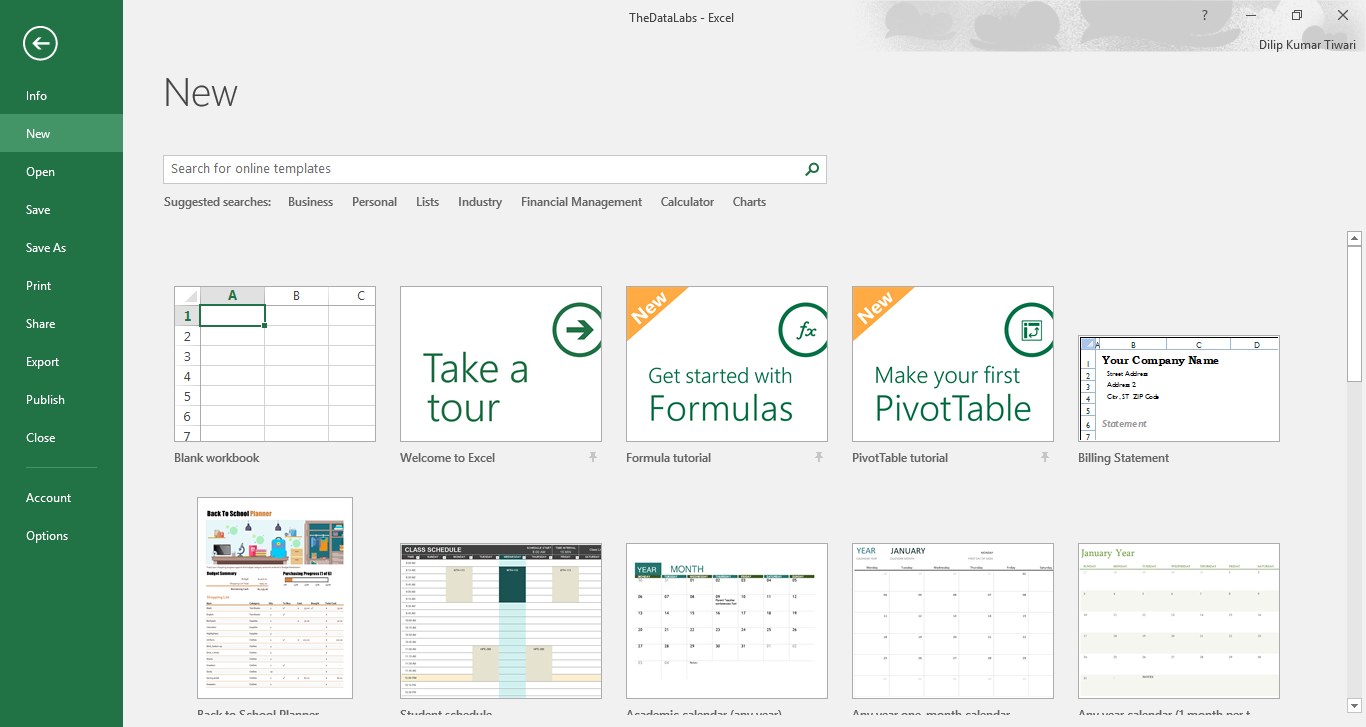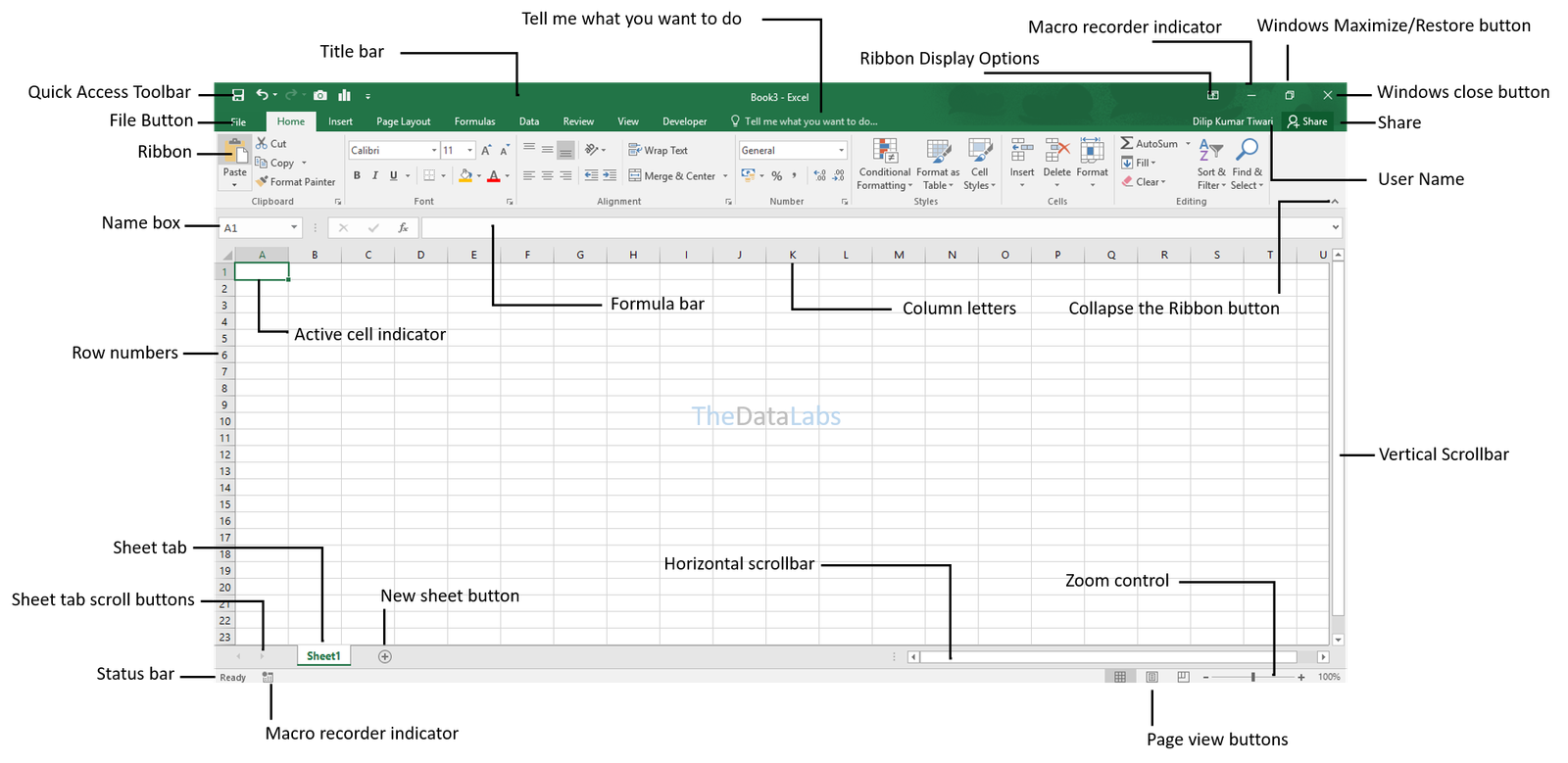About Excel
Excel is a Spreadsheet Program that allows you to store, organize, and analyze information. Anyone can learn how to take advantage of the program’s powerful features in managing and processing data. No matter you’re keeping a budget, organizing a training log, processing raw data, preparing reports/dashboard or creating an invoice, Excel always makes it easy to work with different types of data.
If you have already used the previous version of Excel e.g. 2010 or 2013, then you will feel like at home in Excel 2019. If you are new to Excel or have spent a lot of time with older versions, you should first take some time to become familiar with the MS Excel interface.
When you start Microsoft Excel 2019 for the very first time, the Microsoft Excel Start Screen will display. From Excel landing screen, you can create a new workbook, and access your latest workbooks or choose a new template from the existing template library.
From the Microsoft Excel Start Screen, find and select a new Blank Workbook to access the Excel application window.

Please refer the below screenshot to know the more important bits and pieces of MS Excel 2016.

Brief explanation of the items shown in above figure.
| Excel Element | Description |
|---|---|
| Active cell Indicator | Active cell has always a dark outline. It can be one of the cell (intersection of 1048576 Rows and 16384 Columns). |
| Collapse the Ribbon button | Collapse the Ribbon button help us in hiding the Ribbon temporarily. Just click on this button to show or hide Ribbon. If you hide the Ribbon then you will have more room for Spreadsheet. |
| Column letters | It indicates the Column numbers alphabetically. It starts from 'A' and goes to 'XFD'. In Excel, we have total 16384 Columns hence 'A' indicates the first column and 'XFD' is for the last column i.e. 16384. |
| File button | This is for Backstage view. You will find lots of options for Excel documents and Settings. You can change several settings and customize your Excel screen and settings from here. |
| Formula bar | Whenever you enter data and formulas in a cell or in selected range, all those value appears in Formula bar. You can make the required changes in cell with the help of Formula bar. |
| Horizontal scrollbar | You can scroll the Excel sheet horizontally with the help of Horizontal scrollbar. |
| Macro recorder indicator | You can record a macro post clicking on the Macro recorder button. The icon gets changed basis the activity you are performing. If you have not started recording then it shows Square button and once you click on this button to record macro then icon gets changed to Dark Circle. You can click on circle to stop the macro recording. |
| Name box | It displays the address of Active cell or the name of the selected objects, ranges and cell. You can name a cell or range with the help of Name box. |
| New Sheet button | This button helps us in adding a new sheet in the active workbook. If you click on this button then a new sheet will get added after the last sheet tab. |
| Page View buttons | These views can be useful for various tasks, especially if you're planning to print the spreadsheet. You can switch to any of the three views i.e. Normal view, Page Layout view, or Page Break view. |
| Quick Access toolbar | Quick Access Toolbar lets you access common commands no matter which tab is selected. By default, it includes the Save, Undo, and Repeat commands. You can add other commands depending on your preference. |
| Ribbon | Excel 2016 uses a tabbed Ribbon system instead of traditional menus. The Ribbon contains multiple tabs, each with several groups of commands. Clicking an item in the tab list changes the Ribbon that is displayed. You will use these tabs to perform the most common tasks in Excel. |
| Ribbon Display Options | You can adjust how the Ribbon is displayed with the Ribbon Display Options. There are three modes in the Ribbon Display Options menu: Auto-hide Ribbon, Show Tabs, Show Tabs and Commands. |
| Row numbers | It show the row numbers starting from 1 to 1,048,576. Clicking on a row number will select the entire row. |
| Share | You can save a copy of file to an online location to collaborate with others. |
| Sheet tabs | Sheet tabs shows the available sheets in current workbook. It help us in identifying the sheet with the help of Sheet name. A workbook can have any number of sheets, and each sheet has its own name. |
| Sheet tab scroll buttons | It helps to scroll the sheet tabs to display all those tabs that are not visible. You can get all the sheets post right-clicking on it. |
| Status bbar | It shows lots of information e.g. status of Num Lock, Caps Lock and Scroll Lock. It also shows the summarized information related to the selected ranges or cell. You can modify the list of information post right-clicking and choosing the desired option. |
| Tab list | You can use these command to display a different Ribbon, similar to a menu. |
| Tell me what you want to do | The Tell me box works like a search bar to help you quickly find tools or commands you want to use. Just enter the keywords you are looking for and hit the enter key. It will show the most relevant help on the entered keywords. |
| Title bar | It displays the name of currently open workbook along with Quick Access Toolbar and some control buttons to modify the window. |
| User name | It displays the name of registered user. |
| Vertical scrollbar | You can use this scroll bar to scroll the sheet vertically. |
| Window Close button | To close the active workbook window, just click on Close button. It will prompt a message if your file is not saved. |
| Window Maximize/Restore button | It works like toggle button. You can maximize the window and restore the same with the help of this button. |
| Window Minimize button | To minimize the Excel window, just click on Window Minimize button. Excel window will appear as an icon in the Windows taskbar. |
| Zoom control | You can use this control to zoom your worksheet In and Out. Zoom range starts from 10% and ends to 400%. |


